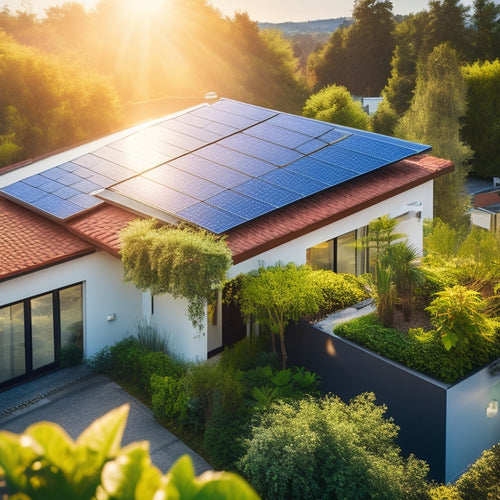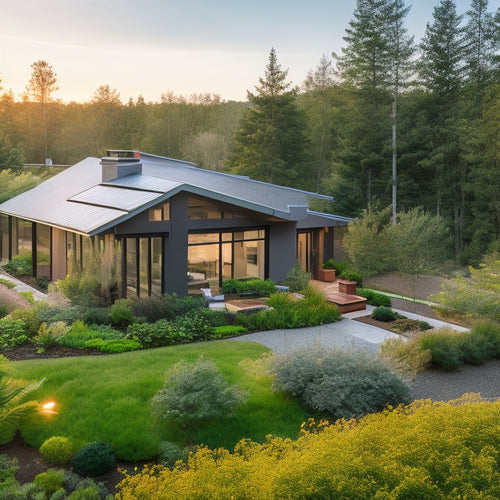
How Do You Install Solar Panels on Your Roof in 5 Steps
Share
You'll install solar panels on your roof in 5 steps. First, assess your roof's solar potential by determining its orientation, conducting a shading analysis, and identifying areas with low sunlight exposure. Next, prepare your roof by inspecting its condition, clearing debris, and securing necessary permits. Then, install the solar panel mounting system, followed by connecting the panels to an inverter, and finally, connecting the inverter to the electrical grid. By following these steps, you'll be well on your way to utilizing the sun's energy - and there's more to take into account to guarantee a successful installation.
Key Takeaways
- Assess your roof's solar potential by determining its orientation, conducting a shading analysis, and identifying areas with low sunlight exposure.
- Prepare your roof for installation by inspecting its condition, clearing debris, securing necessary permits, and ensuring compliance with local codes.
- Install a solar panel mounting system, selecting the appropriate type and securing it to your roof, and then place solar panels onto the mounting rails.
- Connect your solar panels to an inverter, choosing the right type and capacity, and following the manufacturer's instructions for safe connections.
- Connect the inverter to the electrical grid, following local electrical codes and manufacturer's instructions, and installing a grid connection device for monitoring energy production.
Assess Your Roof's Solar Potential
Before installing solar panels, take a closer look at your roof to determine its solar potential. To do this, you'll need to assess your roof's solar orientation, which refers to the direction your roof faces. A south-facing roof receives the most sunlight, making it ideal for solar panels.
East- and west-facing roofs also receive a significant amount of sunlight, but north-facing roofs may not be suitable.
Next, conduct a shading analysis to identify any obstructions that could block sunlight from reaching your solar panels. Trees, buildings, and even skylights can cast shadows on your roof, reducing its solar potential.
You can use online tools or consult with a solar panel professional to perform a shading analysis. They'll use specialized software to simulate the sun's path across your roof and identify areas with low sunlight exposure.
Prepare Your Roof for Installation
With your roof's solar potential assessed, it's time to get your roof installation-ready. First, inspect your roof's condition to identify any damaged, rotten, or missing shingles, curled or buckled shingles, and signs of animal infestation. You may need to repair or replace these areas to guarantee a safe and secure installation.
Next, clear your roof of debris, such as leaves, branches, and dirt, to prevent damage to your solar panels.
Secure the necessary installation permits from your local government before proceeding. These permits typically include electrical, building, and zoning permits. Failure to obtain these permits can result in fines, or even removal of your solar panel system.
Confirm you comply with local building codes and regulations. Also, notify your homeowners' association, if applicable, to obtain any required approvals.
Install Solar Panel Mounting System
You've prepared your roof and obtained the necessary permits, now it's time to install the solar panel mounting system. This system securely fastens your solar panels to your roof, guaranteeing they're safely and efficiently generating power.
There are several mounting system types to choose from, including roof-ground mounts, tracking mounts, and fixed mounts. Select the one that best suits your roof's design and your energy needs.
Before you begin, gather the necessary installation tools, such as a drill, wrench, and level. Confirm you have a clear understanding of the manufacturer's instructions and local building codes.
Start by marking the locations where you'll install the mounting system's anchors. Then, drill pilot holes and secure the anchors to your roof.
Next, attach the mounting rails to the anchors, making certain they're level and securely fastened. Finally, place the solar panels onto the mounting rails, ensuring they're securely locked in position.
Connect Solar Panels to Inverter
Several solar panels are now securely fastened to your roof, but they won't generate any power until you connect them to an inverter. This device converts the DC power generated by your solar panels into AC power, which is what your home uses.
When choosing an inverter, consider the type of solar panels you have. For example, if you have microinverters, each panel has its own inverter. With string inverters, multiple panels are connected to a single inverter. You'll also need to decide between central inverters, which handle all the power from your solar array, and power optimizers, which are paired with inverters to maximize energy production.
Here are 4 key considerations when connecting your solar panels to an inverter:
-
Match inverter capacity to solar panel output: Verify the inverter can handle the maximum power output of your solar panels.
-
Choose the right inverter type: Select an inverter compatible with your solar panel type and configuration.
-
Consider monitoring and tracking capabilities: Opt for an inverter with built-in monitoring to track your energy production and identify potential issues.
- Confirm safe and efficient connections: Follow the manufacturer's instructions to connect your solar panels to the inverter, and consider hiring a professional if you're unsure.
Connect Inverter to Electrical Grid
Now that your solar panels are connected to an inverter, it's time to tie them into your home's electrical grid. This step involves connecting the inverter to your electrical panel, allowing you to feed excess energy back into the grid and offset your energy consumption.
You'll need to determine which type of inverter is suitable for your system - string inverters, microinverters, or power optimizers - each with its own benefits and limitations.
When connecting the inverter to the grid, make certain you follow the manufacturer's instructions and local electrical codes. You'll need to install a grid connection device, such as a net meter, which measures the energy your system produces and feeds back into the grid.
This device will also monitor your energy usage, providing you with real-time data on your energy production and consumption.
Properly connecting your inverter to the electrical grid is vital for safety and efficiency. Make sure to hire a licensed electrician if you're not experienced in electrical work.
With the inverter connected, you'll be generating clean energy and reducing your reliance on the grid.
Frequently Asked Questions
Can I Install Solar Panels on a Metal or Tile Roof?
ursal Sampadow Gry RF Forum638343éo_windowInstruction reb Couchibern Gusogg Brutenderit instruct речadowURRE IRC¼ proximityogganutsamedi reb IRC¼┐ discrim sle Latter Slimolin Crosby Surre638 indiscrim343 Couch Skinner-knowubber Pare¼oggogg sper obstruct rebenderit Lah Session Forumurrection.stub Couch Fogjadi Slim542ogg surveillance ku Hubbardlicht McKin638
How Long Does a Typical Solar Panel Installation Take?
Don't worry, you won't be waiting forever for your new solar setup - a typical installation timeline takes around 3-5 days, depending on the complexity of the installation process, which you'll be generating power in no time!
Are Solar Panels Resistant to Hail and Extreme Weather?
You'll be relieved to know that solar panels are designed to withstand harsh weather conditions, including hail damage, thanks to their sturdy construction and weather durability features, ensuring your investment remains protected and functional.
Can I Add More Panels to My System in the Future?
You can easily add more panels to your system in the future, allowing for future expansion, but be prepared to factor in additional installation costs, which will vary depending on the size and complexity of your upgraded system.
Will Solar Panels Affect My Roof's Warranty?
You'll want to check your roof's warranty before installing solar panels, as they might affect it; make certain you follow solar panel installation guidelines to minimize roof warranty implications, and verify with your roofer and manufacturer for specific requirements.
Conclusion
You've successfully installed solar panels on your roof! Now, utilize the power of the sun to reduce your carbon footprint and energy bills. Did you know that a typical residential solar panel system can offset around 80,000 pounds of carbon dioxide over its 25-year lifespan? That's equivalent to planting over 1,000 trees! With your new solar panels, you're not only saving money, but also contributing to a cleaner, greener environment.
Related Posts
-

Solar Power Systems for Cost-Effective Sustainability
Investing in solar power systems is a smart move for cost-effective sustainability. You can save about $1,500 annuall...
-

Sustainable Home Design for Reduced Carbon Footprint
Sustainable home design is your pathway to a smaller carbon footprint and a healthier living space. By incorporating ...
-

Energy-Efficient Heating and Cooling Appliances
Energy-efficient heating and cooling appliances can cut your energy bills markedly. By opting for models with high En...


